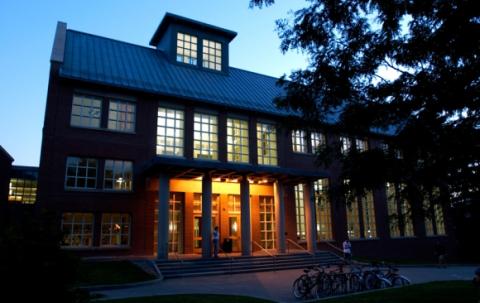UNH’s Dimond Library is among hundreds of UNH buildings connected to a 10 Gbps Internet access network.
Some years ago, "broadband" at UNH meant a 1.5 Mbps T1 line. How times have changed.

A flash-forward reveals a tremendous technology progression that has seen the UNH system leap from an early-generation network architecture to a world-class, converged infrastructure that now connects the Durham, N.H. campus and beyond with aggregate Internet capacity of over 10 gigabits per second, making the UNH system among the most advanced in higher education from a network standpoint. From streaming video piped into residence halls to the transfer of academic research data to peer institutions, the UNH network accommodates tremendous amounts of digital information, providing a sort of early model of where broadband technology is going.
The sheer scale of broadband at UNH is exemplified by the number of infrastructure components, users and advances in capability that are at work within the network’s three main constituent elements. Overall, the UNH network serves more than 30,000 users in New Hampshire and across New England. Here are the key network components at a glance:
- The UNH Campus LAN provides ubiquitous, high-speed wired and Wi-Fi connectivity to laboratories, classrooms, residence halls and outdoor areas over 13,000 Ethernet connections and 1,500 Wi-Fi access points. It has evolved from speeds measured in kilobits per second to today’s 10 Gbps network.
- The USNH Wide Area Network, providing communications and collaboration within the University system and beyond, is a dual-ring infrastructure employing dense wave division multiplexing and carrier Ethernet technologies that has produced orders of magnitude increases in bandwidth since its creation to support better information sharing among the UNH community. Backbone speeds for networks connecting the UNH, Keen State College and Plymouth State University campuses operate at multiples of 10 Gbps.
- In New Hampshire, UNH collaborates with the state in orchestrating the development of the Network New Hampshire Now project, a multi-pronged broadband infrastructure initiative providing resources for high-speed networking throughout the state.
Role of research
Part of the impetus for building an advanced telecommunications network comes from UNH’s heritage in academic research. As research specialists assemble and sift through massive amounts of digital data, the need for increased bandwidth rises in turn. An example is the University’s Environmental Response Management Application, a geographic information systems tool that assists emergency responders and environmental resource managers in dealing with environment-impacting disasters, natural or otherwise. Researchers allied with the ERMA program received and sent 1.2 terabytes of data daily, an amount of traffic that could easily engulf a less capable network. Another power user is the Judd Gregg Meteorology Institute at Plymouth Statue University, which collects and distributes meteorological data that adds up to 560 gigabytes per day over the UNH network. Those demands are only going to grow as science and research move into a so-called “fourth paradigm” built around data-intensive discovery, says Doug Green, Network Architect for UNH. Overlay applications like live, high-definition video conferencing also are highly useful in academic research, but are only now coming to the forefront “because the bandwidth is now here.”
Recognizing that a research-driven need for bandwidth is only going to grow from here, Green says that although UNH operates one of the nation’s most advanced networks for higher education, UNH and its Information Technology group aren’t done yet. The overarching ambition is to put into place a network with enough capacity, resilience and reliability “to appear transparent to the user experience,” he says. When delivering multi-petabytes of gene-sequence data across the network to a research team in a distant location is as easy – and as easily taken for granted – as flipping a light switch to illuminate a room, his work will be done.
